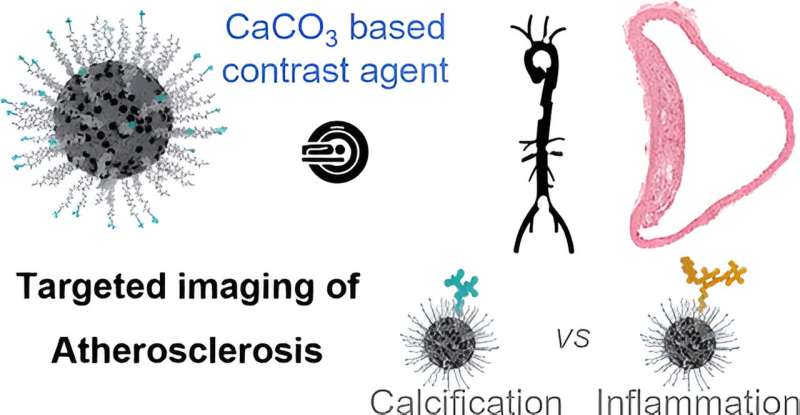
Atherosclerosis is characterized by the hardening of blood vessels, especially certain arteries, due to the local buildup of fibers and lipids (mainly cholesterol) in the inner wall of an artery, causing it to narrow. It is a complex disease that can trigger life-threatening events, such as myocardial infarction and ischemic stroke.
Despite the severity of this disease, conventional diagnostic protocols lack specificity and fail to predict the type of atherosclerotic lesion or the risk of plaque rupture.
As the CIC biomaGUNE Ikerbasque research professor Jesús Ruiz-Cabello explained, “diagnosing plaque vulnerability remains a challenge due to the lack of effective diagnostic tools. To address this problem, technologies, such as the noninvasive medical imaging of atherosclerotic plaque using customized nanotechnology solutions, are emerging. However, due to the porosity of the plaque, obtaining images using nanoparticles remains a difficult task.”
A CIC biomaGUNE team led by Ruiz-Cabello, together with Ikerbasque research professor Susana Carregal –both members of the biomedical research networking center CIBERES–, has developed contrast agents to achieve the selective molecular imaging of atherosclerotic plaques using ultrasmall amorphous calcium carbonate nanoparticles. Calcium carbonate (CaCO3) is a safe, biocompatible material with a long history of use in textiles, cosmetics and foodstuffs.
In this work, published in the journal ACS Nano, the team compared various nanoparticles specifically designed for different features of atherosclerosis (such as calcification or inflammation), which provide useful information about the phase or stage of plaque development.
“We managed to modulate the biological interactions and contrast of these nanoparticles for various imaging techniques, including magnetic resonance imaging, by carefully designing their physico-chemical properties,” said Carregal. “Our work shows that Gd(III)-doped amorphous calcium carbonate nanoparticles are an effective tool due to their high magnetic resonance contrast and physico-chemical properties.”
The novelty and impact of the work lies in the combination of materials science, molecular imaging and biomedicine to design safe, biocompatible contrast agents with advanced properties for magnetic resonance imaging.
“Our results demonstrate the potential of this simple yet groundbreaking nanoprobe, which could inspire new designs of contrast agents for atherosclerosis and other types of diseases, and offer the possibility of formulating new theranostic agents (that can be used for therapeutic as well as diagnostic purposes),” they concluded.
More information:
Lydia Martínez-Parra et al, A Comparative Study of Ultrasmall Calcium Carbonate Nanoparticles for Targeting and Imaging Atherosclerotic Plaque, ACS Nano (2023). DOI: 10.1021/acsnano.3c03523
Journal information:ACS Nano
Provided by
CIC biomaGUNE

READ MORE
This Year’s Future Con Showcased Cutting-Edge Science and Real-Life Superheroes
NASA Administrator Jim Bridenstine talks about getting American astronauts to the moon in the next [...]
A method to fabricate long rolls of subnanocomposite dielectric polymers
Roll-to-roll solution casting equipment. Credit: Yang et al. Engineers and material scientists have been trying [...]
Giant ‘Murder’ Hornet Has Landed at the Natural History Museum
A clutch of kids gathers around entomologist Matt Buffington at the Smithsonian’s National Museum of [...]
How do you use self-tapping screws for aluminum?
Screws for aluminum make it easier to work on the material, and they last longer. [...]
Science’s 300-Year-Old Grand Unification Theory
Those noble Swedes took a break from plotting to shoot people through the Northern Lights [...]
How to Identify and Fix a Coolant Leak
Engine Overheating: Coolant leaks can lead to engine overheating, causing potential damage. naruecha jenthaisong / [...]
Dengue Fever and Zika Virus Make Humans More Attractive to Mosquitoes
The yellow fever mosquito, Aedes aegypti, spreads dengue fever, Zika, chikungunya and other viruses that [...]
Scientists Are Using These High-Tech Tools to Study Bird Migration
Migrating waterbirds over South Dakota’s Huron Wetland Management District on North America’s Central Flyway. Sandra [...]